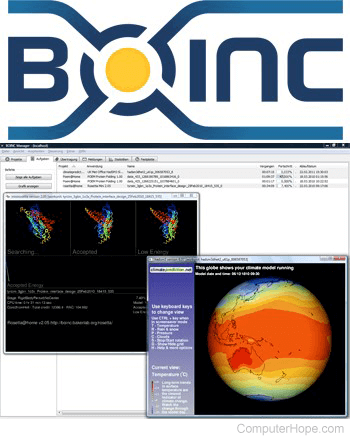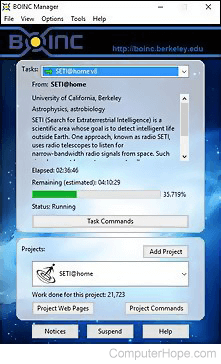BOINC

BOINC (Berkeley Open Infrastructure for Network Computing) is middleware that enables users all over the world to help solve important scientific and mathematical problems. Launched on April 10, 2002, it was developed at the Space Sciences Laboratory at UC Berkeley, which in 1999 launched the SETI@Home project. BOINC was created to build upon the success of SETI@Home, and expand the platform model to other scientific problems that require massive computing power.
How does BOINC work?
Users install the BOINC software on their computer or mobile device, and contribute their spare CPU (central processing unit) and GPU (graphics processing unit) resources to a specific computing project. The resources are only used if the machine is idle, and with mobile devices, plugged-in with the battery charged to at least 90%.
BOINC is a form of distributed computing, although it is more accurately called volunteer computing or grid computing. Comprising over 310,000 participants and 800,000 devices, if the BOINC system were a single computer, it would be the fourth most powerful supercomputer in the world.
Scientific fields
Each scientific problem computed by BOINC has its own dedicated project middleware. Fields of science with one or more dedicated projects include:
- Mathematics
- Linguistics
- Medicine
- Molecular biology
- Climatology
- Environmental science
- Astrophysics
- Physics
- Evolution
- Computer Science
Supported devices

Depending on the project, the supported operating systems, architectures, and devices may include one or more of the following:
- Microsoft Windows
- macOS
- iOS
- Android
- Linux with Intel or ARM (Advanced RISC Machine) architectures
- BSD (Berkeley Software Distribution)
- GPUs: NVIDIA, Radeon, or Intel
- VirtualBox VMs (virtual machines)
As of this writing, all BOINC projects support Microsoft Windows and Linux on Intel.
Projects
Projects operating on the BOINC platform include:
- Acoustics@home — analyze recorded underwater acoustic data, to help paint a picture of the world's oceanographic characteristics.
- Amicable Numbers — search for pairs of numbers where the sum of the proper divisors of each equals the other number. Independently coordinated.
- Asteroids@home — calculate the shape and spin of the vast population of detected asteroids in space. Coordinated by Charles University in Prague.
- Climateprediction.net — generate and verify climate models at Oxford University.
- Collatz Conjecture— help study the mathematical problem: nx is any positive integer. If nx is even, nx+1 equals nx divided by 2. If nx is odd, nx+1 equals nx multiplied by 3, plus 1. The conjecture is that no matter what positive integer is chosen for nx, the sequence always arrives at 1. Independently coordinated.
- DBN Upper Bound — compute the Reimann zeta function, an important function in number theory related to the distribution of prime numbers.
- DENIS@home — perform cardiac electrophysiological simulations for San Jose University, Zaragoza, Spain.
- Distributed Hardware Evolution Project — evolve future hardware designs for autonomous vehicles, medical equipment, and aeronautic industries, using genetic algorithms. Coordinated by the University of Sussex.
- Einstein@home — search for weak astrophysical signals from spinning neutron stars (pulsars). Coordinated by the University of Wisconsin, Milwaukee, and the Max Planck Institute for Gravitational Physics, Hanover, Germany.
- Enigma@home — attempt to decode three unbroken Enigma messages intercepted in the North Atlantic in 1942.
- Gerasim@home — test and compare heuristic methods for designing parallel algorithms and logic control systems.
- GPUGrid.net — compute full-atom molecular dynamics for biomedical research, optimized for NVIDIA GPUs. Coordinated by the Barcelona Biomedical Research Park.
- LHC@home — investigate particle physics problems based on observations made by the LHC (Large Hadron Collider) operated by CERN.
- Milkyway@home — create a highly-accurate 3D model of the Milky Way galaxy using data gathered by the Sloan Digital Sky Survey. Coordinated by RPI (Rensselaer Polytechnic Institute).
- Moo! Wrapper — run cryptography and combinatorics applications, coordinated by distributed.net.
- NanoHUB@home — provide computing power for the nanoscience department of Purdue University.
- NFS@home — use the Number Field Sieve method to help factorize large integers. Coordinated by California State University Fullerton.
- NumberFields@home — search for patterns in number fields, to help number theorists get a deeper understanding of the profound properties of numbers. Coordinated by Arizona State University.
- ODLK — contribute to a mathematical database of "canonical forms of diagonal Latin squares of the tenth order." Independently coordinated.
- Primaboinca — search for counterexamples to two important conjectures about the identification of prime numbers. Coordinated by Hochschule ReinMain University, Wiesbaden, Germany.
- PrimeGrid — search for various forms of large primes, including the largest known prime number. Independently coordinated.
- Radioactive@home — contribute to a free and continuously updated map of radiation levels around the globe. Users must purchase a sensor and attach it to their computer. Coordinated by BOINC Poland Foundation.
- RakeSearch — identify pairs of diagonal Latin squares. Coordinated by Karelian Research Center, Russian Academy of Sciences.
- RNA World — identify, analyze, structurally predict, and design RNA (ribonucleic acid) molecules. Coordinated by Rechenkraft.net e.V.
- Rosetta@home — determine the 3D shapes of molecules that may lead to cures for major human diseases, such as HIV (human immunodeficiency virus), malaria, cancer, and Alzheimer's. Coordinated by the University of Washington.
- SETI@home
- SRBase — solve Sierpinski/Riesel bases (mathematical problems). Independently coordinated.
- Universe@Home — help calculate a database of simulated data for the early Universe. Coordinated by the University of Warsaw.
- World Community Grid — process important research on HIV, cancer, neglected diseases, solar energy, clean water, and other humanitarian issues that impact global health. Coordinated by IBM.
- Yoyo@home — a "BOINC adapter" that adapts grid computing power to multiple BOINC projects, coordinated by BOINC.
Computer acronyms, Computer science, Network terms, Virtual machine
